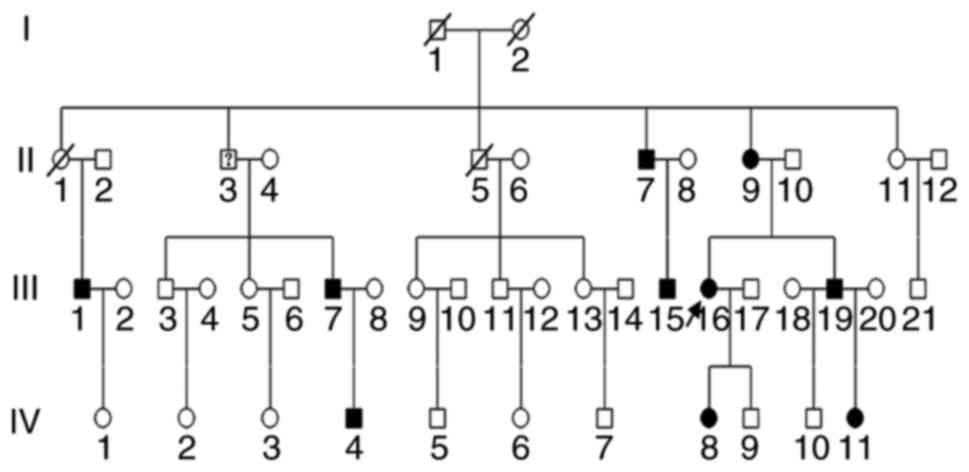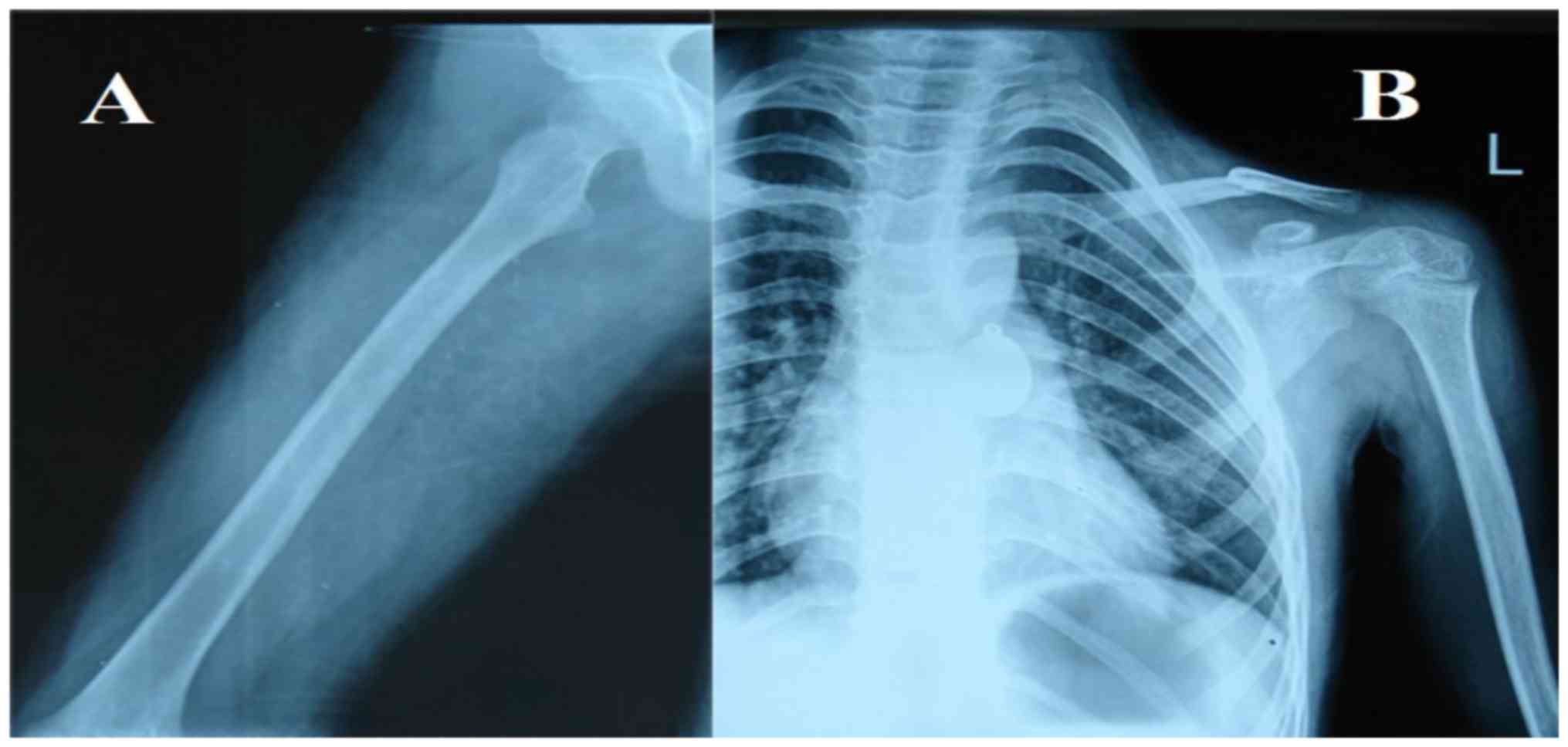|
1
|
Pollitt R, Mcmahon R, Nunn J, Bamford R,
Afifi A, Bishop N and Dalton A: Mutation analysis of COL1A1 and
COL1A2 in patients diagnosed with osteogenesis imperfecta type
I–IV. Hum Mutat. 27:7162006. View Article : Google Scholar : PubMed/NCBI
|
|
2
|
Forlino A and Marini JC: Osteogenesis
imperfecta. Lancet. 387:1657–1671. 2016. View Article : Google Scholar : PubMed/NCBI
|
|
3
|
Sillence DO and Rimoin DL: Classification
of osteogenesis imperfecta. Lancet. 1:1041–1042. 1978. View Article : Google Scholar : PubMed/NCBI
|
|
4
|
Xia XY, Cui YX, Huang YF, Pan LJ, Yang B,
Wang HY, Li XJ, Shi YC, Lu HY and Zhou YC: A novel RNA-splicing
mutation in COL1A1 gene causing osteogenesis imperfecta type I in a
Chinese family. Clin Chim Acta. 398:148–151. 2008. View Article : Google Scholar : PubMed/NCBI
|
|
5
|
Semler O, Garbes L, Keupp K, Swan D,
Zimmermann K, Becker J, Iden S, Wirth B, Eysel P, Koerber F, et al:
A mutation in the 5′-UTR of IFITM5 creates an in-frame start codon
and causes autosomal-dominant osteogenesis imperfecta type V with
hyperplastic callus. Am J Hum Genet. 91:349–357. 2012. View Article : Google Scholar : PubMed/NCBI
|
|
6
|
Zhang ZL, Zhang H, Ke YH, Yue H, Xiao WJ,
Yu JB, Gu JM, Hu WW, Wang C, He JW and Fu WZ: The identification of
novel mutations in COL1A1, COL1A2, and LEPRE1 genes in Chinese
patients with osteogenesis imperfect. J Bone Miner Metab. 30:69–77.
2012. View Article : Google Scholar : PubMed/NCBI
|
|
7
|
Chan TF, Poon A, Basu A, Addleman NR, Chen
J, Phong A, Byers PH, Klein TE and Kwok PY: Natural variation in
four human collagen genes across an ethnically diverse population.
Genomics. 91:307–314. 2008. View Article : Google Scholar : PubMed/NCBI
|
|
8
|
Hald JD, Folkestad L, Harsløf T, Lund AM,
Duno M, Jensen JB, Neghabat S, Brixen K and Langdahl B: Skeletal
phenotypes in adult patients with osteogenesis
imperfecta-correlations with COL1A1/COL1A2 genotype and collagen
structure. Osteoporos Int. 27:3331–3341. 2016. View Article : Google Scholar : PubMed/NCBI
|
|
9
|
Rauch F and Glorieux FH: Osteogenesis
imperfect. Lancet. 363:1377–1385. 2004. View Article : Google Scholar : PubMed/NCBI
|
|
10
|
Bacchelli C and Williams HJ: Opportunities
and technical challenges in next-generation sequencing for
diagnosis of rare pediatric diseases. Expert Rev Mol Diagn.
16:1073–1082. 2016. View Article : Google Scholar : PubMed/NCBI
|
|
11
|
Hoornaert KP, Vereecke I, Dewinter C,
Rosenberg T, Beemer FA, Leroy JG, Bendix L, Björck E, Bonduelle M,
Boute O, et al: Stickler syndrome caused by COL2A1 mutations:
Genotype-phenotype correlation in a series of 100 patients. Eur J
Hum Genet. 18:872–880. 2010. View Article : Google Scholar : PubMed/NCBI
|
|
12
|
Pace JM, Wiese M, Drenguis AS, Kuznetsova
N, Leikin S, Schwarze U, Chen D, Mooney SH, Unger S and Byers PH:
Defective C-propeptides of the proalpha2(I) chain of type I
procollagen impede molecular assembly and result in osteogenesis
imperfecta. J Biol Chem. 283:16061–16067. 2008. View Article : Google Scholar : PubMed/NCBI
|
|
13
|
Martin E and Shapiro JR: Osteogenesis
imperfecta: Epidemiology and pathophysiology. Curr Osteoporos Rep.
5:91–97. 2007. View Article : Google Scholar : PubMed/NCBI
|
|
14
|
Malfait F, Symoens S, De Backer J,
Hermanns-Lê T, Sakalihasan N, Lapière CM, Coucke P and De Paepe A:
Three arginine to cysteine substitutions in the pro-alpha
(I)-collagen chain cause Ehlers-Danlos syndrome with a propensity
to arterial rupture in early adulthood. Hum Mutat. 28:387–395.
2007. View Article : Google Scholar : PubMed/NCBI
|
|
15
|
Cabral WA, Makareeva E, Letocha AD,
Scribanu N, Fertala A, Steplewski A, Keene DR, Persikov AV, Leikin
S and Marini JC: Y-position cysteine substitution in type I
collagen (alpha1(I) R888C/p.R1066C) is associated with osteogenesis
imperfecta/Ehlers-Danlos syndrome phenotype. Hum Mutat. 28:396–405.
2007. View Article : Google Scholar : PubMed/NCBI
|
|
16
|
Rauch F, Lalic L, Roughley P and Glorieux
FH: Relationship between genotype and skeletal phenotype in
children and adolescents with osteogenesis imperfect. J Bone Miner
Res. 25:1367–1374. 2010.PubMed/NCBI
|
|
17
|
Ward LM, Lalic L, Roughley PJ and Glorieux
FH: Thirty-three novel COL1A1 and COL1A2 mutations in patients with
osteogenesis imperfecta types I–IV. Hum Mutat. 17:4342001.
View Article : Google Scholar : PubMed/NCBI
|
|
18
|
Benusiené E and Kucinskas V: COL1A1
Mutation analysis in Lithuanian patients with osteogenesis
imperfecta. J Appl Genet. 44:95–102. 2003.PubMed/NCBI
|
|
19
|
Byers PH: Haploinsufficiency for mutations
in type I collagen genes: Mechanisms and clinical effects. Elsevier
Inc; pp. 1–127. 2013
|
|
20
|
Ben Amor IM, Roughley P, Glorieux FH and
Rauch F: Skeletal clinical characteristics of osteogenesis
imperfecta caused by haploinsufficiency mutations in COL1A1. J Bone
Miner Res. 28:2001–2007. 2013. View Article : Google Scholar : PubMed/NCBI
|
|
21
|
Wang X, Pei Y, Dou J, Lu J, Li J and Lv Z:
Identification of a novel COL1A1 frameshift mutation, c.700delG, in
a Chinese osteogenesis imperfecta family. Genet Mol Biol. 38:1–7.
2015. View Article : Google Scholar : PubMed/NCBI
|
|
22
|
Breathnach R, Benoist C, O'Hare K, Gannon
F and Chambon P: Ovalbumin gene: Evidence for a leader sequence in
mRNA and DNA sequences at the exon-intron boundaries. Proc Natl
Acad Sci USA. 75:4853–4857. 1978; View Article : Google Scholar : PubMed/NCBI
|
|
23
|
Xia XY, Cui YX, Huang YF, Pan LJ, Yang B,
Wang HY, Li XJ, Shi YC, Lu HY and Zhou YC: A novel RNA-splicing
mutation in COL1A1 gene causing osteogenesis imperfecta type I in a
Chinese family. Clin Chim Acta. 398:148–151. 2008. View Article : Google Scholar : PubMed/NCBI
|












